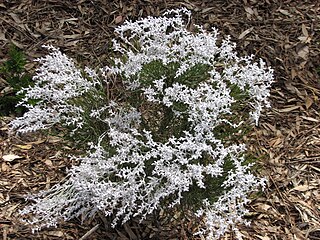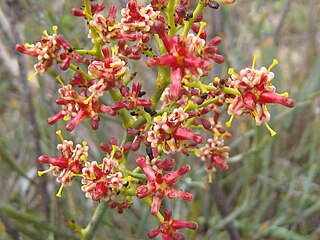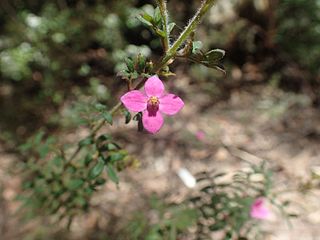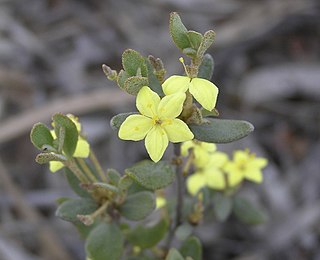
Anthocercis, commonly known as tailflower, is a genus of shrubs which are endemic to southern temperate Australia with the center of distribution in the South West Botanical Province of Western Australia. All species of Anthocercis contain tropane alkaloids, and have occasionally caused poisoning in children or been suspected of poisoning stock. Anthocercis is known as the only Solanaceous plant known to produce resin compounds on glandular trichomes.

Conospermum stoechadis, commonly known as common smokebush, is a shrub endemic to Western Australia.
Conospermum stoechadis subsp. sclerophyllum is a shrub endemic to Western Australia.

Stirlingia, commonly known as blueboy, is a genus of 7 species in the family Proteaceae, all of which are endemic to Western Australia.

Anthocercis viscosa, also known as sticky tailflower, is a species of shrub in the family Solanaceae, native to the south coast of Western Australia. It grows up to 3 metres in height and produces white or cream flowers between May and February in its native range.
Verticordia harveyi, commonly known as autumn featherflower, is a flowering plant in the myrtle family, Myrtaceae and is endemic to the south-west of Western Australia. It is a slender, spindly shrub with relatively long leaves and small white, pink or magenta-coloured flowers in late summer and autumn.

Anthocercis littorea, also known as yellow tailflower, is a species of shrub in the family Solanaceae. It's native to Western Australia where it grows on coastal limestone and dunes as well as sandplains.
Calytrix gracilis is a species of plant in the myrtle family Myrtaceae that is endemic to Western Australia.

Xanthorrhoea gracilis, commonly known as the graceful grasstree, grassboy or mimidi, is a species of grasstree of the genus Xanthorrhoea native to Western Australia.

Boronia gracilipes, commonly known as karri boronia, is a plant in the citrus family, Rutaceae and is endemic to the south-west of Western Australia. It is an erect, spindly shrub with compound leaves and pink, four-petalled flowers.

Boronia capitata, commonly known as the cluster boronia, is a plant in the citrus family, Rutaceae and is endemic to the south-west of Western Australia. It is a slender, spreading shrub with simple leaves and pink, four-petalled flowers.

Marianthus tenuis is a species of flowering plant in the family Pittosporaceae and is endemic to the southwest of Western Australia. It is a slender, twining shrub with clustered, narrowly elliptic leaves and white flowers tinged with mauve and with darker spots on three of the five petals.

Leucopogon gracilis is a species of flowering plant in the heath family Ericaceae and is endemic to the south of Western Australia. It is a spindly shrub with wiry branchlets, linear to lance-shaped leaves, and dense spikes of white or pinkish flowers.

Asterolasia squamuligera, commonly known as yellow starbush, is a species of erect, woody, slender perennial shrub that is endemic to the southwest of Western Australia. It has leathery, egg-shaped leaves with the narrower end towards the base and yellow flowers arranged in umbels of five to ten with a fringe of scales on the back of the petals, and about ten stamens.
Sphaerolobium gracile is a species of flowering plant in the family Fabaceae and is endemic to the south-west of Western Australia. It is a low, straggling or prostrate shrub that typically grows to a height of up to 0.8 m and has a few short, linear leaves and yellow or orange flowers from September to January.

Sphaerolobium grandiflorum is a species of flowering plant in the family Fabaceae and is endemic to the south of Western Australia. It is an erect, slender, leafless shrub with red, yellow and orange flowers.
Leucopogon cryptanthus, commonly known as small-flowered leucopogon, is a species of flowering plant in the heath family Ericaceae and is endemic to the south-west of Western Australia. It is slender, diffuse, much-branched shrub that typically grows to a height of about 15 cm (5.9 in). Its leaves are erect and linear, 2–6.5 mm (0.079–0.256 in) long, rigid and sharply pointed. The few flowers are small and inconspicuous, arranged singly, in short spikes or in clusters at the ends of branches in cymes with leaf-like bracts and bracteoles at the base. The sepals are less than 2 mm (0.079 in) long, the petals joined at the base, forming a tube shorter than the sepals, the petal lobes about as long as the petal tube.

Leucopogon florulentus is a species of flowering plant in the heath family Ericaceae and is endemic to the south-west of Western Australia. It is slender, erect shrub that typically grows to a height of 30–80 cm (12–31 in). Its leaves are thick, erect and egg-shaped, sometimes with the narrower end towards the base, and 2–3 mm (0.079–0.118 in) long. The flowers are densely arranged in spikes at the ends of many branchlets with egg-shaped bracts and bracteoles less than 0.8 mm (0.031 in) long at the base. The sepals are about 1.6 mm (0.063 in) long, the petals 2–3 mm (0.079–0.118 in) long and joined at the base, forming a tube, the petal lobes about as long as the petal tube.

Leucopogon leptantha is a species of flowering plant in the heath family Ericaceae and is endemic to the south-west of Western Australia. It is an erect, bushy shrub that typically grows to a height of about 30 cm (12 in). Its leaves are erect, oblong or egg-shaped and 4–6 mm (0.16–0.24 in) long with a small, hard point on the tip. The flowers are arranged singly or in pairs in leaf axils with small bracts and bracteoles less than half as long as the sepals. The sepals are about 1.6 mm (0.063 in) long, the petals joined at the base to form a tube about 4 mm (0.16 in) long with lobes about 2 mm (0.079 in) long.
Senna goniodes is a species of flowering plant in the family Fabaceae and is endemic to the far north of Western Australia. It is an erect, slender shrub with pinnate leaves with two or three pairs of narrowly elliptic to elliptic leaflets, and yellow flowers arranged in groups with ten fertile stamens in each flower.













